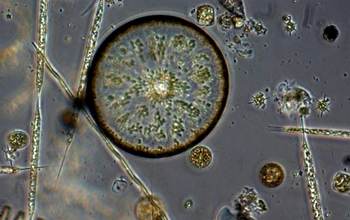Multimedia Gallery
Diatoms from Puget Sound, Wash.
Diatoms from Puget Sound, Wash. Diatoms--tiny phytoplankton abundant in the sea--are a critical part of the marine environment.
A research team from the J. Craig Venter Institute (JCVI) and other institutions discovered that diatoms have an animal-like urea cycle, and that this cycle enables the diatoms to efficiently use carbon and nitrogen from their environment. The team believes the cycle could be a reason for the domination of diatoms in marine environments, especially after upwelling events--the upward movement of nutrient rich waters from the deep ocean to the surface. In response to ocean upwelling, diatoms are able to quickly recover from prolonged periods of nutrient deprivation and rapidly proliferate.
The study--supported in part by the National Science Foundation--has provided a fascinating insight into how diatoms have evolved to become the dominant primary producers in many ocean regions.
Read more about this research in the NSF press release Scientists discover animal-like urea cycle in tiny diatoms in the ocean. (Date of Image: 2011)
Credit: Adrian Marchetti, University of Washington, and Andrew Allen, JCVI
See other images like this on your iPhone or iPad download NSF Science Zone on the Apple App Store.
Images and other media in the National Science Foundation Multimedia Gallery are available for use in print and electronic material by NSF employees, members of the media, university staff, teachers and the general public. All media in the gallery are intended for personal, educational and nonprofit/non-commercial use only.
Images credited to the National Science Foundation, a federal agency, are in the public domain. The images were created by employees of the United States Government as part of their official duties or prepared by contractors as "works for hire" for NSF. You may freely use NSF-credited images and, at your discretion, credit NSF with a "Courtesy: National Science Foundation" notation.
Additional information about general usage can be found in Conditions.
Also Available:
Download the high-resolution JPG version of the image. (1.7 MB)
Use your mouse to right-click (Mac users may need to Ctrl-click) the link above and choose the option that will save the file or target to your computer.



